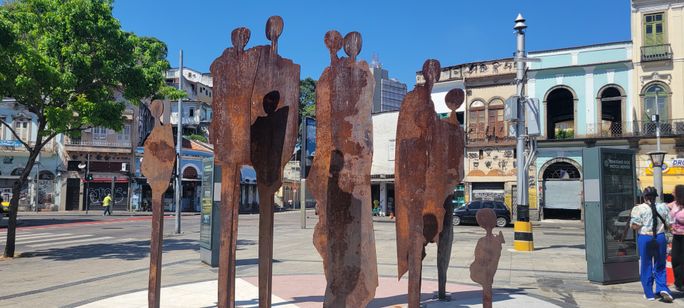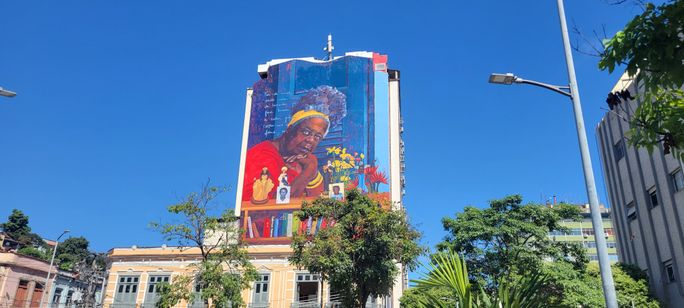
by Brian Major
Last updated: 8:35 AM ET, Fri May 2, 2025
A heightened focus on Brazil��s African heritage is a driving factor in the South American country��s surging visitor arrivals.
In 2024, Brazil recorded its?best-ever year?for international arrivals, with 6,657,377 foreign visitors, a 12.6 percent year-over-year increase compared with 2023, according to Embratur, the country��s tourism promotion agency.
Brazil��s tourism success continued during this year��s first quarter. The country hosted 3.7 million visitor arrivals in the first three months of 2025, a year-over-year increase of nearly 50 percent compared with 2024, according to data from Embratur
and Brazil��s Ministry of Tourism and Federal Police.
The increase follows government initiatives to promote indigenous Afro-Brazilian heritage and culture, expressed in the music, cuisine and creative artistry found in cosmopolitan Rio de Janeiro and regions including Salvador da Bahia.
Last year, Embratur launched ��It's spectacular. It's for you,�� a promotional campaign designed to ��[reinforce] the diversity, sustainability, and Afro-tourism of destinations in Brazil.��
Distributed online via digital platforms and social networks, the campaign��s video follows a traveler as she journeys through Brazilian cities and regions, including Rio de Janeiro and Salvador da Bahia. Both cities offer districts, activities and attractions
tied to Brazil��s African heritage.
Valongo Wharf and Pequena Africa
Brazil��s promotion of the nation��s African heritage addresses a painful legacy, as the country imported more enslaved Africans during the trans-Atlantic era than any other country.
Of the 12 million Africans forcibly brought to the Western Hemisphere, approximately 5.5 million arrived in Brazil between 1540 and the 1860s, with Rio de Janeiro the primary port of entry.
Today, minutes from Copacabana beach and other Rio landmarks, travelers will find the Cais do Valongo pier or Valongo Wharf, a UNESCO World Heritage site located in the city��s port district.
Constructed in 1811, the wharf served as the chief landing point for enslaved Africans arriving in Brazil. The site was also where enslaved Africans were auctioned and sold. During its 20 years of operation, between 500,000 and one million enslaved Africans
arrived at?Valongo Wharf.?
Valongo Wharf was first converted from a landing point for enslaved persons to a commercial pier in 1843 for the landing of the then Brazilian empress Princess Teresa Cristina. The wharf was subsequently known as Cais da Imperatriz (Empress Wharf).
Brazilian authorities reluctantly enforced a European ban on slave trading beginning in 1850. Between that year and 1920, the neighborhood surrounding Valongo Wharf became residence to formerly enslaved persons of several nations. Black Brazilian composer
Heitor dos Prazeres?reportedly dubbed the district ��Pequena ?frica�� (Little Africa), a nickname that endures to this day.
Buried under the 1843 conversion and later by urban development, Valongo Wharf was unearthed in 2016 as Brazil prepared for the Olympic Games.

The art installation at Rio de Janeiro��s Valongo Wharf in ��Pequena Africa�� commemorates the millions of enslaved Africans who arrived at the port. (Photo by Brian Major)
The site now houses an extensive outdoor art installation featuring displays of historic documents and images, period drawings and newspaper articles, plus artwork detailing the plight of enslaved people and slavery��s history in Brazil.
The adjoining neighborhood, ��Pequena Africa�� or ��Little Africa,�� is a center of Black culture that developed into a hub for Afro-Brazilian resistance and gave birth to samba music and Carnival celebrations.
The walkable district features small restaurants, bars and craft shops among its public streets lined with Colonial-era residential buildings. Throughout the area, street murals celebrating Afro-Brazilian dance, culture and artistry adorn walls and buildings.
One prominent mural features writer?Concei??o Evaristo, whose work often explores racism, sexism, class oppression, and the legacy of slavery in Brazil.
A bronze statue at one end of the district celebrates?Mercedes Baptista, a ballet dancer and choreographer who became the first black woman
to join Theatro Municipal do Rio de Janeiro's corps de ballet in 1948.
Inspired by legendary African American choreographer, anthropologist and civil rights figure Katherine Dunham, with whom she visited and studied in the 1950s, founded Brazil��s Ballet Folcl��rico Mercedes Baptista, dedicated to the support and promotion
of Black dancers who researched and incorporated Afro-Brazilian culture into their art.
Baptista is credited with the creation of Afro-Brazilian ballet, inspired dances associated with Candombl��, the indigenous faith shared by Salvador��s African-descendant residents.

Pequena Africa��s murals include one featuring famed writer Concei??o Evaristo. (Photo by Brian Major)
��Places like Pequena Africa (Little Africa), down by the harbor in Rio de Janeiro and the Afro-Brazilian mecca of Bahia, are vibrant, colorful and filled with a majority Black population,�� said Felicia Fencl, founder and CEO of First Choice Travel Group.
��There is Afro-Brazilian music playing in the streets, colorful murals and statues and a strong?sense of belonging,�� Fencl said. ��The vibe is electric and the people are welcoming and accepting. For Black travelers especially, ��It is truly a homecoming
experience,�� Fencl said.
Guided tours of the district are available and offer an excellent way to uncover the district��s significance.
Sizzling Salvador
Salvador, the capital city of the Brazilian state of Bahia, features culinary, fine art, dance, musical and spiritual experiences, activities and attractions inspired by Brazil��s Black population. Salvador served as Brazil��s capital from 1549 to 1763 and was a major port during the transatlantic slave trade. The municipality today is home to the country's largest population of African descendants.
The city��s annual Carnival celebration, held annually beginning in February on the Friday before Ash Wednesday, is a fervent, week-long event that encompasses one of the world��s largest street parties, spanning seven musical circuits across the city.
The ��Ax���� Afro-Caribbean rhythms blaring from tractor-trailer trucks equipped with huge sound systems incorporate reggae, calypso and Brazilian beats. Other celebrations are held at nightclubs, hotels and musical venues around the city. Ceremonies at
Candombl�� temples are also observed.
Carnival in Rio
Rio��s Carnival is of course, one of the most celebrated around the world. Between February 24 and March 8 of this year, 310,609 international travelers arrived in Brazil, with 40 percent visiting Rio de Janeiro, according to research firm ForwardKeys.?
Most recently, Carnival event organizers have sought to honor their roots in Afro-Brazilian culture.?The 2025 samba school parades at Rio��s famed Sapucai Sambadrome included numerous floats designed to celebrate Afro-Brazilian culture and honor the event��s
roots in that culture��s celebrations.
This year��s samba competition was won by the Beija-Flor samba school, whose leader, legendary samba singer?and composer Neguinho da Beija-Flor, announced his retirement after nearly five decades.
The performer��s real name is Luiz Ant?nio Feliciano Marcondes; the stage name ��Neguinho�� refers to his African heritage. Considered in some circumstances as a pejorative term in reference to a Black boy or man, it is also an affectionate term among Afro-Brazilians,
a circumstance the singer said led to his choice to adopt the nickname.
For the latest travel news, updates and deals, subscribe to the daily TravelPulse newsletter.
Topics From This Article to Explore